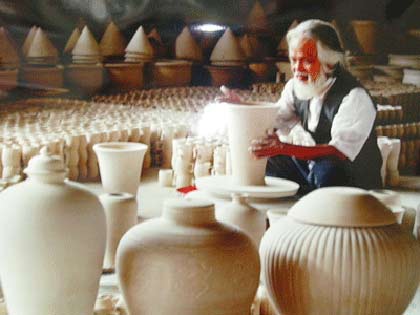Charter Cruises
Premium Cruises
Superior Cruises
Honeymoon Cruises
Incentive Cruises
Hanoi develops craft village tourism

Hanoi's People's Committee issued Program 154/UBND-CT on developing tourism associated with craft villages for the 2012-2015 period, with the aim of creating favorable conditions for craft villages in the capital to promote their strengths.
With 1,350 craft villages, including 244 traditional villages, Hanoi is the country's largest home for craft villages. Hanoi's traditional craft villages are particularly attractive for international and domestic traveler, including Bat Trang Ceramic Village, Van Phuc Silk Village, Ha Thai Lacquer Village, Son Dong Wood Carving Village, and Chuyen My Mosaic Village. Visiting these craft villages, visitors will not just be interested in shopping, but also in direct contact with artisans and participating in their work. Therefore, these villages are indispensable destinations in the City's tour for many tourists in recent years.
With 1,350 craft villages, including 244 traditional villages, Hanoi is the country's largest home for craft villages. Hanoi's traditional craft villages are particularly attractive for international and domestic traveler, including Bat Trang Ceramic Village, Van Phuc Silk Village, Ha Thai Lacquer Village, Son Dong Wood Carving Village, and Chuyen My Mosaic Village. Visiting these craft villages, visitors will not just be interested in shopping, but also in direct contact with artisans and participating in their work. Therefore, these villages are indispensable destinations in the City's tour for many tourists in recent years.
Taking that into account, Hanoi's People's Committee issued a tourism-craft village development program fro the 2012-2015 period, which is believed by travel experts, to contribute to improving the quality of tourism in the city's craft villages.
The program aims at specific objectives of increasing the proportion of industrial production value by craft villages to 8.4 percent against the city's total industrial production value by 2015; the city's tourism revenue up from 16 to18 percent annually; and the number of tourists to 2.5-3 million, including around 500,000 international travelers and more than two million domestic tourists.
To achieve these objectives, the program has also set out a number of tasks and key measures including picking out several craft villages with tourism potential in Hanoi to develop traditional craft village tours; deploying tourism infrastructure construction in the selected craft villages; organizing tours to craft villages associated with visiting the historical and cultural monuments; training human resource for the city's tourism sector; and promoting craft village tourism via inter-regional cooperation.
The selected craft villages will have traditional houses, old houses and architectural spaces preserved. In addition, craft households in these villages will be supported in terms of production and exhibition of their products.
According to travel experts, craft village tours will be deployed in the 2012-2015 period, providing favorable conditions for Hanoi's tourism to develop, introducing to visitors the unique quintessential features of the capital city.
(Source: VEN)
Other news
- Tuan Chau island - an ideal place for holiday on Summer 2013
- Vietnam Airlines offers 27 percent off for Europe flights
- US cruise ship brings visits central region and Halong Bay in Feb 20 2013
- Temple of Literature decorated Lunar New Year Festival
- MV Henna cruise ship visited Halong Bay on Jan 27, 2013
Latest News
- Tuan Chau island - an ideal place for holiday on Summer 2013
- Vietnam Airlines offers 27 percent off for Europe flights
- US cruise ship brings visits central region and Halong Bay in Feb 20 2013
- Temple of Literature decorated Lunar New Year Festival
- MV Henna cruise ship visited Halong Bay on Jan 27, 2013
Quick Questions
Why Choose Us









